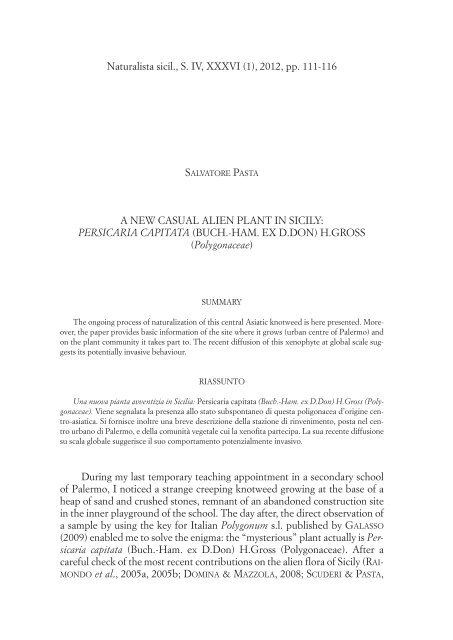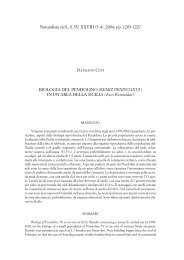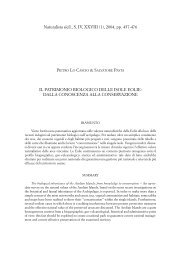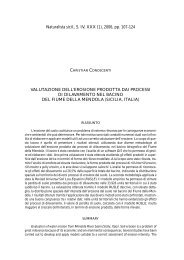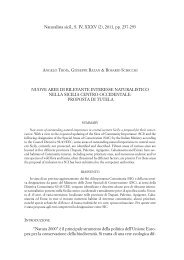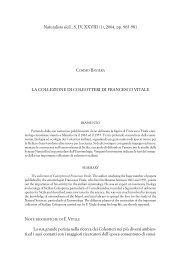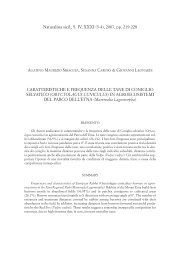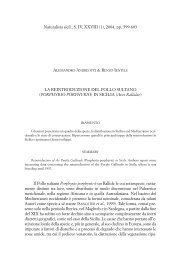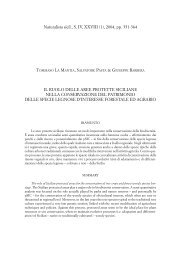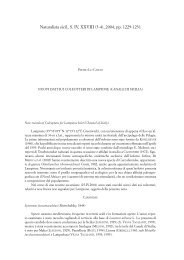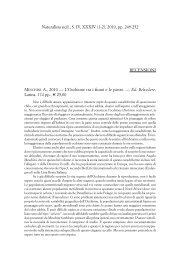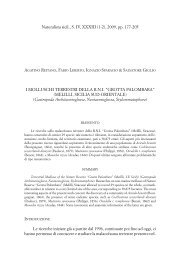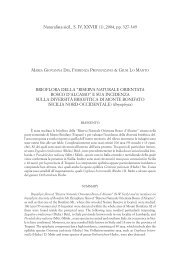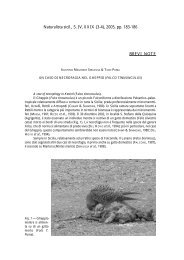PERSICARIA CAPITATA (BUCH.-HAM. EX D - sssn.it
PERSICARIA CAPITATA (BUCH.-HAM. EX D - sssn.it
PERSICARIA CAPITATA (BUCH.-HAM. EX D - sssn.it
Create successful ePaper yourself
Turn your PDF publications into a flip-book with our unique Google optimized e-Paper software.
Naturalista sicil., S. IV, XXXVI (1), 2012, pp. 111-116SALVATORE PASTAA NEW CASUAL ALIEN PLANT IN SICILY:<strong>PERSICARIA</strong> <strong>CAPITATA</strong> (<strong>BUCH</strong>.-<strong>HAM</strong>. <strong>EX</strong> D.DON) H.GROSS(Polygonaceae)SUMMARYThe ongoing process of naturalization of this central Asiatic knotweed is here presented. Moreover,the paper provides basic information of the s<strong>it</strong>e where <strong>it</strong> grows (urban centre of Palermo) andon the plant commun<strong>it</strong>y <strong>it</strong> takes part to. The recent diffusion of this xenophyte at global scale suggests<strong>it</strong>s potentially invasive behaviour.RIASSUNTOUna nuova pianta avventizia in Sicilia: Persicaria cap<strong>it</strong>ata (Buch.-Ham. ex D.Don) H.Gross (Polygonaceae).Viene segnalata la presenza allo stato subspontaneo di questa poligonacea d’origine centro-asiatica.Si fornisce inoltre una breve descrizione della stazione di rinvenimento, posta nel centrourbano di Palermo, e della comun<strong>it</strong>à vegetale cui la xenof<strong>it</strong>a partecipa. La sua recente diffusionesu scala globale suggerisce il suo comportamento potenzialmente invasivo.During my last temporary teaching appointment in a secondary schoolof Palermo, I noticed a strange creeping knotweed growing at the base of aheap of sand and crushed stones, remnant of an abandoned construction s<strong>it</strong>ein the inner playground of the school. The day after, the direct observation ofa sample by using the key for Italian Polygonum s.l. published by GALASSO(2009) enabled me to solve the enigma: the “mysterious” plant actually is Persicariacap<strong>it</strong>ata (Buch.-Ham. ex D.Don) H.Gross (Polygonaceae). After acareful check of the most recent contributions on the alien flora of Sicily (RAI-MONDO et al., 2005a, 2005b; DOMINA & MAZZOLA, 2008; SCUDERI & PASTA,
112 S. PASTA2009) and Italy (CELESTI-GRAPOW et al., 2009), <strong>it</strong> may be assessed that this isnot only the first official record for Sicilian vascular flora, but also for all Centraland Southern Italy. In fact, up to now <strong>it</strong>s presence has been reported onlyfrom Piedmont (AESCHIMANN et al., 2004), while some recent photos on twodifferent national internet s<strong>it</strong>es testify the ongoing naturalization of thisspecies also on two islands of Naples province in Campania (Capri, april2008: cfr. www.naturamed<strong>it</strong>erraneo.com/forum; Ischia, june 2008, GraziaSergi: cfr. www.actaplantarum.org/acta) and along the coasts of Liguria(Zoagli, Genova Province, 200 m a.s.l., january 2011, Daniela Longo: cfr.www.actaplantarum.org/acta).Persicaria cap<strong>it</strong>ata (Fig. 1) is native to the Himalayan area, where <strong>it</strong> growsin N Pakistan, N India, Bhutan, Nepal and W China (QAISER, 2001). Outsideof <strong>it</strong>s natural range this plant prefers full sun, but <strong>it</strong> is able to tolerate partialshade. It often grows on disturbed, rather humid urban places such as rockcrevices, stone walls, roadsides, but <strong>it</strong> also invades subnatural ecosystems likefallows, artificial forests and orchards.Introduced worldwide (LI et al., 2003), mostly as a garden groundcover(GLEASON &CRONQUIST, 1991), once established <strong>it</strong> can be difficult to eradicateas <strong>it</strong> can spread prolifically. During the last two decades <strong>it</strong> performed animpressive colonization success of all the continents, mostly in the biomescharacterized by warm-temperate climate, being recorded as an invasive plantin U.S.A (e.g. West Coast and Hawaii: WESTER, 1992), Central and SouthAmerica (Mexico, Costa Rica, Colombia, Venezuela and Brasil: MEIER, 2003),Taiwan (HSU et al., 2004), Australia and New Zealand (GROVES et al., 2005;HOWELL, 2008), Tropical and South Africa (HENDERSON, 2008). In Europe,this weed is known for Portugal, N Spain, Azores (CASTROVIEJO et al., 1990),Madeira (HANSEN & SUNDING, 1993), Un<strong>it</strong>ed Kingdom (CLEMENT & FOSTER,1994; STACE, 1997) and Greece (STRID & TAN, 1997; ARIANOUTSOU et al.,2010).Once dried, the collected and studied specimen was given to the HerbariumMed<strong>it</strong>erraneum of Palermo (PAL). The label of the exsiccatum containsthe following information: “Centro storico di Palermo, Ist<strong>it</strong>uto d’IstruzioneSuperiore Regina Margher<strong>it</strong>a, cortile interno tra il plesso centrale ed il plesso“Protonotaro”, comun<strong>it</strong>à ruderali su cumuli di sabbia e pietrisco, 20 m s.l.m.,coord. 38°06’86’’ Nord, 13°21’85’’ Est, S. Pasta, 2.III.2012”.Local population of Persicaria cap<strong>it</strong>ata is probably formed by a singleindividual which up to now occupies an area of c. 1 m 2 , where <strong>it</strong> co-occurstogether w<strong>it</strong>h few n<strong>it</strong>rophilous species typical to different classes of synanthropicvegetation such as Parietarietea judaicae Oberdorfer 1977 (chasmon<strong>it</strong>rophilousplant commun<strong>it</strong><strong>it</strong>es), Stellarietea mediae R. Tx. Lohmeyer &Preising ex von Rochow 1951 (annual, herb-rich ruderal commun<strong>it</strong>ies), Poly-
A new casual alien plant in Sicily: Persicaria cap<strong>it</strong>ata113abFig. 1 a-b — Particular of Persicaria cap<strong>it</strong>ata (D.Don) H.Gross (photo: S. Pasta and S. Mandalà,7.III.2012).
114 S. PASTAgono-Poëtea annuae Rivas-Martínez 1975 (short-lived, trampled ruderal plantcommun<strong>it</strong>ies), etc. (Table 1).This xenophyte is probably escaped from a private garden in the surroundings,and <strong>it</strong> may have been introduced in the playground by one of theTable 1Phytosociological relevés of the plantassemblages co-occurring w<strong>it</strong>h Persicaria cap<strong>it</strong>ata (S. Pasta, 5.III.2012).Substratum abbreviations: sa = (calcareous) sands; ce = cement; cs = crushed (calcareous) stones.Nr of relevé 1 2 3 4 5 6 7Total cover rate (%) 90 100 30 30 40 30 90Surface (m 2 ) 1 1 1 2 2 2 1Substratum sa ce ce cs cs sa ceAspect N N S S N N SAverage slope (°) 0 0 0 10 40 30 0Persicaria cap<strong>it</strong>ata (Buch.-Ham. ex D. Don) H. Gross 5Char. Parietarietea judaicae Oberdorfer 1977Parietaria judaica L. + 5 2 + 1 + 4Antirrhinum siculum L. r + 2 1 +Char. Stellarietea mediae R. Tx. Lohmeyer & Preising ex von Rochow 1951Solanum nigrum L. r r r rSenecio vulgaris L. + + +Urtica membranacea Poir. + +Erigeron canadense L. r rSonchus oleraceus L. +Galact<strong>it</strong>es tomentosa MoenchrHordeum sp.rRicinus communis L.rChar. Polygono-Poëtea annuae Rivas-Martínez 1975Polycarpon tetraphyllum (L.) L. + + + + rTrisetaria aurea (Ten.) Pignatti +Cardamine hirsuta L. +Char. Lygeo-Stipetea tenacissimae Rivas-Martínez 1978Symphyotrichum squamatum (Spreng.) G.L. NesomrPiptatherum miliaceum (L.) Coss. +Char. Stipo-Trachynietea distachyae Brullo in Brullo, Scelsi & Spampinato 2001Hypochoeris glabra L.rMusci indet. 1 + + + 1 1 +Hepaticae indet. + +
A new casual alien plant in Sicily: Persicaria cap<strong>it</strong>ata115Yellow-legged gulls (Larus michahellis) nesting on the roofs of the neighbouringbuildings. In fact, these colonial birds seem to play an important roleas vectors of plant propagules (CALDARELLA et al., 2011).Acknowledgements — I am grateful to my friends Riccardo Guarino and Leonardo Scuderi,who improved the final version of the manuscript w<strong>it</strong>h their suggestions. My student Sofia Mandalàkindly helped me to take the photos.REFERENCESAESCHIMANN D., LAUBER K., MOSER D.M. & THEURILLAT J.-P., 2004 — Flora alpina. — Zanichelli,Bologna, 3 voll.ARIANOUTSOU M., BAZOS I., DELIPETROU P. & KOKKORIS Y., 2010 — The alien flora of Greece:taxonomy, life tra<strong>it</strong>s and hab<strong>it</strong>at preferences. — Biol. Invasions, 12: 3525-3549.CALDARELLA O., LA ROSA A., PASTA S. & DI DIO V., 2010 — La flora vascolare della Riserva NaturaleOrientata Isola delle Femmine (Sicilia nord-occidentale): aggiornamento dellacheck-list e commento del turnover. — Naturalista sicil., 34 (3-4): 421-476.CASTROVIEJO S., LAÍNZ M., LÓPEZ GONZÁLEZ G., MONTSERRAT P., MUÑOZ GARMENDIA F., PAIVA J.& VILLAR R. (eds.), 1990 — Flora Iberica. Plantas vasculares de la Península Ibéricae Islas Baleares. Vol. 2: Platanaceae-Plumbaginaceae (partim). — Real Jardín Botánico,C.S.I.C., Madrid, LII + 897 pp., 206 figg.CELESTI-GRAPOW L., ALESSANDRINI A., ARRIGONI P.V., ASSINI S., BANFI E., BARNI E., BOVIO M.,BRUNDU G., CAGNOTTI M., CAMARDA I., CARLI E., CONTI F., DEL GUACCHIO E.,DOMINA G., FASCETTI S., GALASSO G., GUBELLINI L., LUCCHESE F., MEDAGLI P., PAS-SALACQUA N., PECCENINI S., POLDINI L., PRETTO F., PROSSER F., VIDALI M., VIEGI L.,VILLANI M. C., WILHALM T. & BLASI C., 2009 — Inventory of the non-native flora ofItaly. — Plant Biosystems, 143 (2): 386-430.CLEMENT E.J. & FOSTER M.C., 1994 — Alien plants of the Br<strong>it</strong>ish Isles. A provisional catalogue ofvascular plants (excluding grasses). — Botanical Society of the Br<strong>it</strong>ish Isles, London,590 pp.DOMINA G. & MAZZOLA P., 2008 — Flora ornamentale delle isole circumsiciliane. — Quad. Bot.ambientale appl., 19: 107-119.GALASSO G., 2009 — I poligoni (Polygonum s.l., Polygonaceae) <strong>it</strong>aliani: ridelim<strong>it</strong>azione dei generi eproposte per una chiave. Pp. 47-49 in: Peccenini S. & Domina G. (eds.), Comunicazionidel Gruppo per la Floristica della Società Botanica Italiana “Gruppi cr<strong>it</strong>ici dellaFlora d’Italia”. — Dipartimento di Biologia Vegetale, La Sapienza Univers<strong>it</strong>à di Roma.GLEASON H.A. & CRONQUIST A., 1991 — Manual of the vascular plants of northeastern Un<strong>it</strong>edStates and adjacent Canada. Ed. 2. — New York Botanical Garden, New York, 910 pp.GROVES R.H., BODEN R. & LONSDALE W.M., 2005 — Jumping the Garden Fence. Invasive gardenplants in Australia and their environmental and agricultural impact. — CSIRO reportprepared for WWF-Australia, Sidney, 173 pp.HANSEN A. & SUNDING P., 1993 — Flora of Macaronesia: checklist of vascular plants. — Sommerfeltia,17: 1-295.HENDERSON L. (ed.), 2008 — Sapia (South African Plant Invaders Atlas) News n° 7. — ARC-PlantProtection Research Inst<strong>it</strong>ute, Weeds Division, Pretoria, 5 pp. (www.agis.agric.za/ wip)HOWELL C., 2008 — Consolidated list of environmental weeds in New Zealand. — Development,292, 42 pp. (http://csl.doc.govt.nz/upload/documents/science-and-technical/drds292.pdf)
116 S. PASTAHSU T.-W., KU S.-M. & PENG C.-I., 2004 — Persicaria cap<strong>it</strong>ata (Buchanan-Hamilton ex D. Don) H.Gross (Polygonaceae), a newly naturalized plant in Taiwan. — Taiwania, 49 (3): 183-187.LI A.-J., BAO B.-J., GRABOVSKAYA-BORODINA A.E., HONG S.-P., MCNEILL J., MOSYAKIN S.L., OHBAH. & PARK C.-W., 2003 — Polygonaceae. Pp. 277-350 in: Wu Z.-Y. & Raven P.H.(eds.), Flora of China, 5. — Science Press, Beijing, Missouri Botanical Garden Press, St.Louis, USA.MEIER W., 2006 — Contribución al conocimiento de Persicaria nepalensis (Meisn.) H. Gross and P.cap<strong>it</strong>ata (Buch. Ham. ex D. Don) H. Gross, especies invasoras en el Parque Nacionalde Avila, Venezuela. — Acta Bot. Venez., 29 (1): 1-16.QAISER W., 2001 — Flora of Pakistan, 205: Polygonaceae. — Missouri Botanical Garden Press, St.Louis, USA, 190 pp.RAIMONDO F.M., DOMINA G., SPADARO V. & AQUILA G., 2005a — Prospetto delle piante avventiziee spontaneizzate in Sicilia. — Quad. Bot. ambientale appl., 15 (2004): 153-164.RAIMONDO F.M., DOMINA G., SPADARO V. & AQUILA G., 2005b — Aggiunte al “Prospetto dellepiante avventizie e spontaneizzate della Sicilia”. — Quad. Bot. ambientale appl., 16:219-220.SCUDERI L. & PASTA S., 2009 — Contributi alla conoscenza della flora vascolare della provincia diTrapani (Sicilia occidentale). II. Xenof<strong>it</strong>e nuove per la provincia, per la Sicilia e perl’Italia. — Naturalista sicil., 33 (3-4): 113-122.STACE C., 1997 – New Flora of the Br<strong>it</strong>ish Isles. 2 nd Ed. – Cambridge Univers<strong>it</strong>y Press, Cambridge,1266 pp.STRID A. & TAN K., 1997 — Flora Hellenica. Vol. I. — Koeltz Scientific Books, Königstein, ix xxvi +1-547 pp., 722 distribution maps.WESTER L., 1992 — Origin and distribution of adventive alien flowering plants in Hawaii. Pp. 99-154 in: Stone C.P., Sm<strong>it</strong>h C.W. & Tunison J.T. (eds.), Alien plants invasion in nativeecosystems of Hawaii: management and research. — Cooperative National ParkResources Studies Un<strong>it</strong>, Univers<strong>it</strong>y of Hawaii, Honolulu. 903 pp.www.actaplantarum.org/acta/albums1.php?id=2532www.naturamed<strong>it</strong>erraneo.com/forum/topic.asp?TOPIC_ID=53150Address of the Author — S. PASTA, via V<strong>it</strong>torio Ziino (già V.F. 19), 60/A — 90126 Palermo (I);e-mail: salvatore.pasta@alice.<strong>it</strong>.


